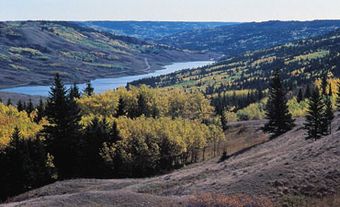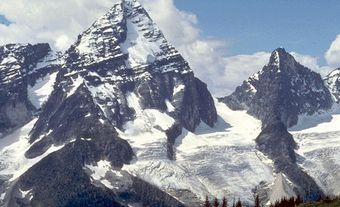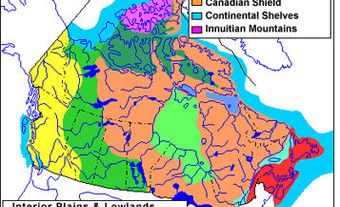Fjord
Fjord, long, narrow bay formed by glacial erosion of river valleys during the ICE AGES and consisting of one or more basins separated by sills. Fjords occur on the coasts of British Columbia and eastern Canada, Alaska, Chile, New Zealand, Greenland and Norway. In cross-section they are U-shaped, often with a flat bottom. The fjords of the Pacific coast are 3-400 km long, 0.6-15 km wide and 20-500 m in average depth. Sill depths range from a few metres to 500 m below the water surface. The water in fjords comes from 2 sources: the ocean supplies salt water, which being dense fills most of the fjord basin; rivers provide lighter fresh water, which forms a layer on top of the salt water. The rivers flowing into fjords are fed by rainfall draining from their watersheds and, in summer, by meltwater from mountain snowfields and glaciers. Glacial meltwater usually carries finely ground rock (rock flour), which gives it a milky appearance. Most of this material is deposited to form the flat bottom which is so typical of many fjords.In oceanographic terminology, fjords are estuaries, ie, semienclosed bodies of water in which seawater is measurably diluted by fresh water from land drainage. As there is a continual supply of river water, usually at the landward end of the fjord, the upper layer (a few metres thick) flows toward the sea, picking up some salt water from below en route and carrying it out to sea. An inflow of salt water from the ocean balances this export. The combination of surface-layer outflow of low-salinity water and deeper inflow of more saline ocean water is known as an estuarine circulation. It serves to exchange or ventilate the basin water. If the outer sill is very shallow, projecting up into the outflowing upper layer, this ventilation is hindered. In this case the basin water stagnates and most or all of its dissolved oxygen is used up by bacterial processes; therefore, fish may be unable to live in it. In some shallow-silled fjords stagnation may persist for years; in others there is an annual cycle in which inflow of deeper salt water occurs seasonally when dense water upwells outside the mouth of the fjord. The degree of ventilation of a fjord basin is important when experts are considering whether or not it may be permissible to discharge industrial effluent or mine tailings into it. Of the many fjords that have been investigated, only a small minority exhibit marked stagnation.
Most of the fjords on the West Coast have been studied. In particular the seasonal variations of water properties in Bute Inlet have been observed for more than 30 years, and intensive studies in Knight Inlet since 1977 have revealed many features of subsurface motions and internal waves. On the East Coast, fewer fjords have been investigated, but the physics, chemistry and geology of Saguenay Fjord, 100 km long and 275 m deep, off the north shore of the St Lawrence estuary, have been investigated in some detail.
See also SAGUENAY RIVER.

 Share on Facebook
Share on Facebook Share on X
Share on X Share by Email
Share by Email Share on Google Classroom
Share on Google Classroom


